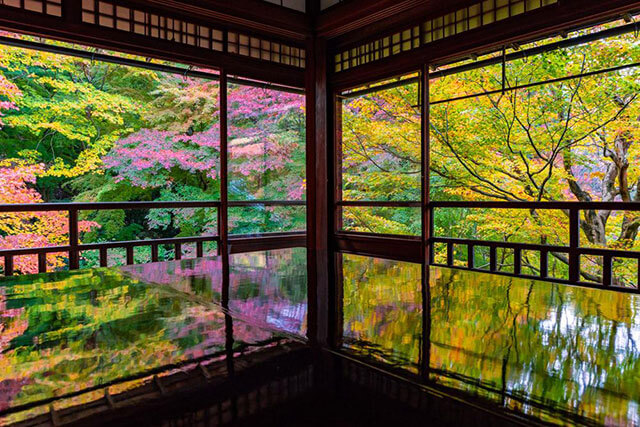
When Rurikoin opens to visitors for limited stretches in spring and autumn, long lines form outside of this idyllic complex in Yase, in the suburban hills of Kyoto. Once a villa and now a Buddhist temple, Rurikoin has become one of the sights to see in the ancient capital.
-
![]()
Even before the railway came, people still made their way out to Yase, a town known as a place of retreat and relaxation. It was here that Emperor Tenmu was dragged, to tend to his wounds (an arrow in his back, to be precise); the story is likely bogus and the folk etymology of the place name is suspect as well (the kanji for “arrow” and “spine” would be pronounced Yase, too, but it’s actually written with the kanji for “eight” and “rapids”). Yase remains one of the prettiest spots in the city, with ryokan and villas spread throughout, including the Shugakuin Imperial Villa.
![]()
Tanaka Gentaro of the Kyoto Railway Company and the Kyoto Electric Lighting Company acquired this particular plot of land in the Taisho period (1912-1926) and built a villa there, given the name Kikakutei. After Tanaka’s truly unusual death and possible assassination—involving a train derailment, a bamboo spear, and rocks in his hakama—the villa became the property of the Kyoto Electric Lighting Company. The corporate landlords eventually turned the villa into a ryokan popular for elite corporate retreats and expanded the kitchen to serve an exclusive restaurant.
![]()
Since Komyoji Temple acquired the villa in the early-2000s and rechristened it Rurikoin, its time as a ryokan has been mostly erased, and little mention is made of Tanaka Gentaro. But the recent history is more colorful than Rurikoin lets on, and it’s just as fascinating to imagine the reclusive Taisho railway boss hiding out in the luxurious villa, while local villagers plotted his assassination over land expropriation beefs, or bubble economy low-level executives meeting at Kikakutei over scotch, cigars, and kaiseki meals.
![]()
No longer the haunt of fathers of industry or bureaucrats and executives, nor, as it was for most of its lifetime, open to the public regularly, Rurikoin has been polished into a gem through costly renovations and is now open only for brief stretches in the spring, when the gardens are coming to life, and in the autumn, during koyo season. The queues that form to enter the grounds can have visitors waiting for hours, but it’s a sign of how special Rurikoin is that thousand gladly wait for their chance to shuffle through.
![]()
The gardens, laid out by the patriarchs of the Ueto Zoen garden design company, are the main attraction of course, and the reason everyone is willing to brave the crowds to enter, but the other buildings on the grounds are impressive as well. Stop by the teahouse, which bears the original name of the villa, Kikakutei, to sip matcha and nibble wagashi. The teahouse and some of the original structures on the property were the work of Nakamura Sotoji, a master carpenter that specialized in tea rooms. Apart from this tea room at Rurikoin, Nakamura also constructed the tea rooms at Ise Shrine, as well as a private tea room for the garden at Kykuit, John D. Rockefeller’s Pocantico Hills estate.
![]()
Rurikoin is now a temple, of course, since it was taken over by Komyoji. After contemplating the gardens and touring the other buildings on the grounds, return to the study hall to take part in sutra copying (guests are provided with all necessary materials), repeating in black ink a portion of Buddhist scripture as a means of making merit.
![]()
Arrive early at Rurikoin, if possible, especially during the autumn months, to avoid excruciatingly long lines later in the day. The trip out on the Eizan Main Line has views of some of the prettiest scenery within the city limits, and there are plenty of detours to take on the way back home, including a museum that houses a collection of Louis Icart’s drawings and etchings.
- Komyoji Temple Rurikoin
-
-
- Kyoto Kyoutoshi Sakyou-ku Kamitakanohigashiyama 55
-
-
-
- 0757814001
-
-
-
- 10:00-16:30(Gates shut 17:00…
-
View All








 Go here
Go here





